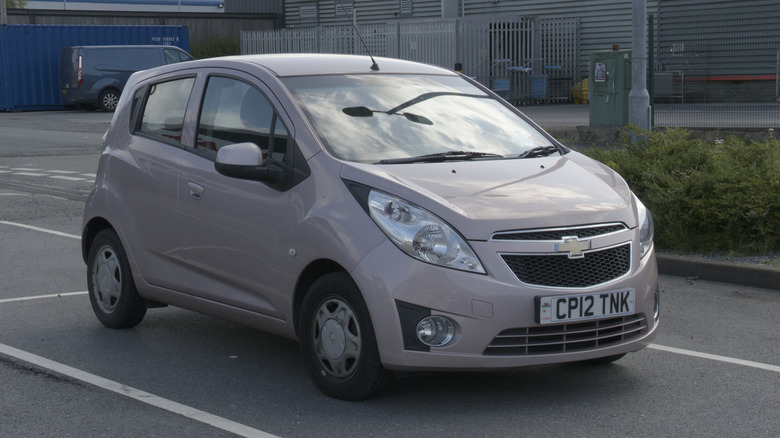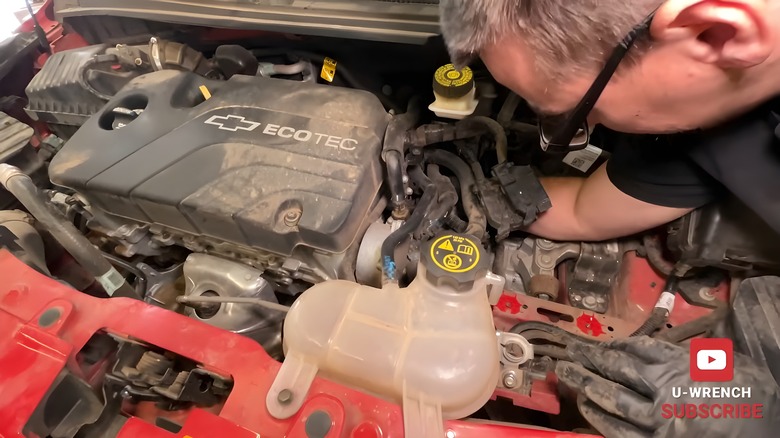Chevy Spark: Which Year Should You Avoid, According To Drivers?
The Chevrolet Spark spent a decade in U.S. showrooms as one of the smallest and cheapest new cars you could buy, aimed at budget commuters, students, and first-time buyers who needed a car that could squeeze into tight spaces. At its best, the Spark was inexpensive to own, easy to park, featured modern tech, and had a surprisingly tall cabin for a car under 150 inches long. But not every year fully lived up to that promise. A closer look at owner feedback, recalls, and service bulletins shows 2013, 2014, and 2015 stacking some of the most serious issues in the Chevy Spark's run.
The 2013 model year became known for engine trouble, particularly complaints of oil consumption and stalling. The following two years, 2014 and 2015, saw a spike in transmission failures, many of which involved costly CVT repairs that surfaced well before 100,000 miles. These years were also hit with multiple safety recalls, including hood-latch corrosion and, in some 2014 cars, front suspension defects.
By comparison, the rest of the vehicle's run — from 2016 through 2022, when Chevrolet discontinued the Spark — was quieter, with fewer serious issues reported and far less overlap between mechanical and safety concerns. That's why, more than a decade later, those early model years continue to stand out in forums, complaint databases, and GM's own documents. If you're wondering which Spark year to avoid, you don't have to look far — drivers have been warning about the same three model years for a decade.
2013 Chevy Spark: Engine problems with oil consumption
The 2013 Spark is the earliest model year sold in the U.S., and it also happens to be the one with the most consistent engine complaints. This model year is linked with widespread oil-consumption issues tied to premature PCV valve wear. That's a technical way of saying that the engine could start burning oil far earlier than expected. CarComplaints even ranks 2013 as the worst Spark year overall, with most complaints focused on oil consumption.
This issue led to blown spark plugs and misfires that for some users would trigger warning lights and, in more than a few cases, stalling. If the oil dropped too low for too long, some owners ended up with internal damage serious enough to require an engine replacement – and on a low-cost car like the Chevy Spark, that kind of repair often costs more than the vehicle is worth. General Motors eventually issued Recall 14110 for this problem, covering both 2013 and 2014 Sparks with the 1.2-liter LL0 engine. However, the recall only addressed the hardware moving forward, meaning cars that had already suffered damage weren't covered for full repairs.
On top of the engine problems, the 2013 Spark was also included in a safety recall for a faulty hood latch mechanism. Corrosion could prevent the latch from securing properly, and in rare cases, the hood could fly open while driving. It was a serious safety concern that added yet another black mark to the Chevy Spark's first year on the market.
2014-2015 Chevy Spark: Expensive transmission failures
The gas-powered Spark's next two years, 2014 and 2015, built their reputation on transmission trouble. Chevrolet replaced the four-speed automatic transmission with the CVT7 automatic to boost fuel economy and smooth out daily driving, but the reality was far less flattering. Owners reported buckling under light acceleration, whining noises, slipping under load, and, in many cases, complete transmission failure well before 100,000 miles. The failures weren't isolated, either. GM eventually acknowledged the pattern in Special Coverage N192271110, which extended the warranty on 2014-2015 CVTs to 10 years or 120,000 miles.
According to GM's bulletin, harsh shift events could damage internal pulleys and the drive belt, sending metal debris into the transmission fluid and accelerating wear. Once contamination began, the transmission often failed quickly. CarComplaints and NHTSA confirm that transmission-related complaints dominated these years. One Reddit user on r/chevyspark even reported going through two complete CVT replacements in their 2014 Spark — both before the car hit 100,000 miles on the odometer.
Transmission problems are expensive on any vehicle, but on a budget commuter like the Spark, replacing a CVT could cost as much as the car's resale value. These issues alone would be enough to sink the 2014-2015 models, but they also carried forward the hood latch corrosion recall affecting 2013 Sparks, which had to be reissued in 2022 when the original fix proved insufficient. Some 2014 Chevrolet Spark models were also recalled for control-arm bolts that hadn't been properly torqued, a defect that could cause the suspension to separate and lead to a loss of steering.
Methodology
For this piece, we looked at customer complaints, in addition to official GM recalls to determine which years to avoid for the Chevy Spark. Across the board, 2013, 2014, and 2015 model years stood out. GM issued targeted campaigns for engine and transmission problems. Complaint volumes spiked in all the usual places. And owners kept sharing stories about the same failures happening more than once — even after so-called fixes.
The 2014 Spark EV, by the way, doesn't factor into this story. It was sold in limited numbers, mostly in California and Oregon, but used a completely different drivetrain. Because it didn't have the oil-burning 1.2-liter engine or the CVT7 transmission, it didn't have the same issues. Instead, this article focuses on the gas-powered Spark models most people will come across in used listings.



